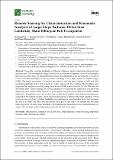Files in this item
Remote sensing for characterisation and kinematic analysis of large slope failures : Debre Sina landslide, Main Ethiopian Rift Escarpment
Item metadata
| dc.contributor.author | Kropacek, Jan | |
| dc.contributor.author | Varilova, Zuzana | |
| dc.contributor.author | Baron, Ivo | |
| dc.contributor.author | Bhattacharya, Atanu | |
| dc.contributor.author | Eberle, Joachim | |
| dc.contributor.author | Hochschild, Volker | |
| dc.date.accessioned | 2019-12-02T13:30:04Z | |
| dc.date.available | 2019-12-02T13:30:04Z | |
| dc.date.issued | 2015-12-02 | |
| dc.identifier | 263517953 | |
| dc.identifier | 81d0b3a7-5313-48c2-b0cd-77f9140eac3d | |
| dc.identifier | 000367534000020 | |
| dc.identifier | 84969601765 | |
| dc.identifier.citation | Kropacek , J , Varilova , Z , Baron , I , Bhattacharya , A , Eberle , J & Hochschild , V 2015 , ' Remote sensing for characterisation and kinematic analysis of large slope failures : Debre Sina landslide, Main Ethiopian Rift Escarpment ' , Remote Sensing , vol. 7 , no. 12 , pp. 16183-16203 . https://doi.org/10.3390/rs71215821 | en |
| dc.identifier.issn | 2072-4292 | |
| dc.identifier.uri | https://hdl.handle.net/10023/19040 | |
| dc.description | This study was carried out in the framework of the German Science Foundation (DFG) project “Integrated assessment of geomorphological process dynamics on different spatio-temporal scales in the Ethiopian Highlands using remote sensing and advanced modelling approaches” (HO1840/11-1) and the Czech Science Foundation (GAČR) project “Mass wasting and erosion as an indicator of morphotectonic activity in the Ethiopian Highlands based on remote sensing approaches” (P209/12/J068). The ALOS/PRISM data were provided by the ESA in the framework of the project ID13160. The aerial photographs were provided by the Ethiopian Mapping Agency. We would like to thank the Gesellschaft für Erd- und Völkerkunde, Stuttgart, Germany for supporting the field campaign in 2015. | en |
| dc.description.abstract | Frequently occurring landslides in Ethiopia endanger rapidly expanding settlements and infrastructure. We investigated a large landslide on the western escarpment of the Main Ethiopian Rift close to Debre Sina. To understand the extent and amplitude of the movements, we derived vectors of horizontal displacements by feature matching of very high resolution satellite images (VHR). The major movements occurred in two phases, after the rainy seasons in 2005 and 2006 reaching magnitudes of 48 ± 10.1 m and 114 ± 7.2 m, respectively. The results for the first phase were supported by amplitude tracking using two Envisat/ASAR scenes from the 31 July 2004 and the 29 October 2005. Surface changes in vertical direction were analyzed by subtraction of a pre-event digital elevation model (DEM) from aerial photographs and post-event DEM from ALOS/PRISM triplet data. Furthermore, we derived elevation changes using satellite laser altimetry measurement acquired by the ICESat satellite. These analyses allowed us to delineate the main landslide, which covers an area of 6.5 km2, shallow landslides surrounding the main landslide body that increased the area to 8.5 km2, and the stable area in the lower part of the slope. We assume that the main triggering factor for such a large landslide was precipitation cumulated over several months and we suspect that the slope failure will progress towards the foot of the slope. | |
| dc.format.extent | 21 | |
| dc.format.extent | 12911013 | |
| dc.language.iso | eng | |
| dc.relation.ispartof | Remote Sensing | en |
| dc.subject | Ethiopian rift | en |
| dc.subject | Tarmaber area | en |
| dc.subject | Debre Sina | en |
| dc.subject | large landslide | en |
| dc.subject | feature tracking | en |
| dc.subject | amplitude tracking | en |
| dc.subject | DEM differencing | en |
| dc.subject | ICESat | en |
| dc.subject | QE Geology | en |
| dc.subject | 3rd-NDAS | en |
| dc.subject.lcc | QE | en |
| dc.title | Remote sensing for characterisation and kinematic analysis of large slope failures : Debre Sina landslide, Main Ethiopian Rift Escarpment | en |
| dc.type | Journal article | en |
| dc.contributor.institution | University of St Andrews. School of Geography & Sustainable Development | en |
| dc.identifier.doi | 10.3390/rs71215821 | |
| dc.description.status | Peer reviewed | en |
This item appears in the following Collection(s)
Items in the St Andrews Research Repository are protected by copyright, with all rights reserved, unless otherwise indicated.

